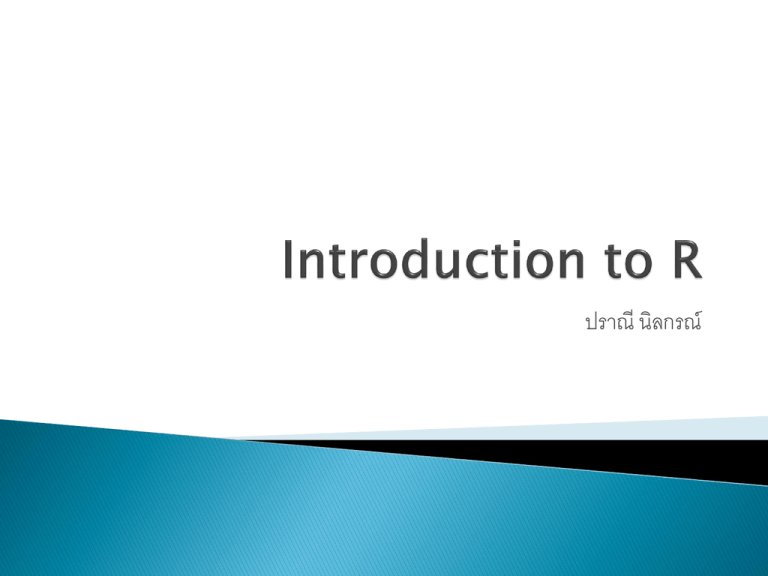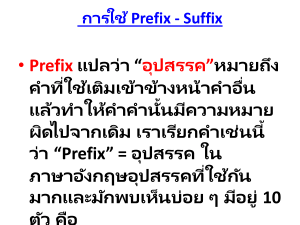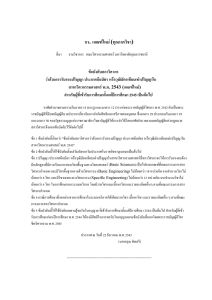Introduction to Program R
advertisement

ปราณี นิลกรณ์ R เป็ นภาษาและโปรแกรมสาเร็จรูปสาหรับการ คานวณทางสถิตแ ิ ละสร ้างกราฟประเภทให ้เปล่า ( free open source package ) ทีพ ่ ัฒนาขึน ้ มาจาก ภาษา S ( S language, Bell Labs) โดย Robert Gentleman และ Ross Ihaka แห่งUniversity of Auckland, New Zealandเมือ ่ ปี 2538 ้ เหมาะทัง้ สาหรับการเขียนโปรแกรมเอง และใชแบบ โปรแกรมสาเร็จรูป ั ทางสถิตใิ ห ้เรียกใชมากมาย ้ มีฟังก์ชน และมีผู ้พัฒนา เพิม ่ อย่างต่อเนือ ่ ง 2 ข ้อมูลทุกอย่างเกีย ่ วกับ R หาอ่านได ้จาก http://www.R-project.org ่ นหลัก คือ R system ประกอบด ้วย 2 สว 1.Base system – ประกอบด ้วย R language software และสว่ นเพิม ่ เติมอืน ่ ๆทีม ่ ค ี วาม จาเป็ นต ้องใชบ่้ อยๆ 2. User contributed add-on packages 3 จะหาโปรแกรม R ได ้จากไหน? ไป download ได ้ที่ www.r-project.org หรือที่ http://CRAN.R-project.org โดยเลือกลงโปรแกรมพืน ้ ฐาน ( Base Package) ้ ถ ้าต ้องการใชแบบเมนู จะต ้องติดตัง้ โปรแกรม Rcmdr เพิม ่ เติม 4 การจัดการข ้อมูลและหน่วยความจา การคานวณในรูป Array และ Matrix การวิเคราะห์ข ้อมูลทางสถิต ิ การสร ้างกราฟ การเขียนโปรแกรม 5 RGui ( Gui – Graphical user interface) ประกอบด ้วย วินโดวส ์ R Console สาหรับเขียนคาสงั่ และแสดงผล ลัพธ์ วินโดวส ์ R Graph สาหรับแสดงกราฟ Script Windows สาหรับเขียน แก ้ไขคาสงั่ โปรแกรม 6 7 8 9 R มี Packages ทีมผ ี ู ้สร ้างสาหรับการคานวณและการวิเคราะห์ ้ ้อย่างสะดวก ข ้อมูลทางสถิต ิ ซงึ่ เราสามารถ ดาวน์โหลดมาใชได และรวดเร็ว มีผู ้พัฒนา packages สาหรับเทคนิคการวิเคราะห์ใหม่ๆนอกจาก ่ data/text mining วิธท ี างสถิตแ ิ บบเดิม เชน นักสถิตท ิ วี่ จ ิ ัยและพัฒนาวิธก ี ารทางสถิตใิ หม่ๆ นิยมเขียนวิธก ี าร เป็ น R packages 10 การทางานกับ R โดยทัว่ ไปคือ พิมพ์คาสงั่ R ตามทีต ่ ้องการ ใน command line interface หรือ โหลดไฟล์ทม ี่ ค ี าสงั่ R อยูแ ่ ล ้ว(Script file) มา run ชา้ แต่มข ี ้อดี คือ เป็ นการบันทึกขัน ้ ตอนการวิเคราะห์ข ้อมูล เก็บไว ้เป็ นไฟล์ สาหรับงานแต่ละงานได ้ เวลาพบความผิดพลาด ทราบได ้ว่าผิดพลาดขัน ้ ตอนไหน ถ ้าการวิเคราะห์ต ้องทาหลายขัน ้ ตอน สามารถนาคาสงั่ มา run ซ้าใหม่ได ้โดยไม่ต ้อง click ใหม่ซ้า ๆ 11 >? t.test or >help(t.test) 12 Fast and free. State of the art: Statistical researchers provide their methods as R packages. SPSS and SAS are years behind R! 2nd only to MATLAB for graphics. Not user friendly @ start - steep learning curve, minimal GUI. No commercial support; figuring out correct methods or how to use a function on your own can be frustrating. Easy to make mistakes and not know. Mx, WinBugs, and other programs Working with large datasets is limited by RAM use or will use R. Data prep & cleaning can be messier & Active user community more mistake prone in R vs. SPSS or SAS Excellent for simulation, programming, computer intensive Some users complain about hostility on the R listserve analyses, etc. Forces you to think about your analysis. Interfaces with database storage software (SQL) 13 Many different datasets (and other “objects”) available at same time One datasets available at a given time Datasets can be of any dimension Datasets are rectangular Functions can be modified Functions are proprietary Experience is interactive-you program until you get exactly what you want Experience is passive-you choose an analysis and they give you everything they think you need One stop shopping - almost every analytical tool you can think of is available Tend to be have limited scope, forcing you to learn additional programs; extra options cost more and/or require you to learn a different language (e.g., SPSS Macros) R is free and will continue to exist. Nothing can make it go away, its price will never increase. They cost money. There is no guarantee they will continue to exist, but if they do, you can bet that their prices will always increase 14 >Variables > a = 49 > sqrt(a) [1] 7 > a = "The dog ate my homework" > sub("dog","cat",a) [1] "The cat ate my homework“ > a = (1+1==3) >a [1] FALSE numeric character string logical 15 > a = c(7,5,1) > a[2] [1] 5 ลิสต์: an ordered collection of data of arbitrary types. > doe = list(name="john",age=28,married=F) > doe$name [1] "john“ > doe$age [1] 28 16 data frame: is supposed to represent the typical data table that researchers come up with – like a spreadsheet. It is a rectangular table with rows and columns; data within each column has the same type (e.g. number, text, logical), but different columns may have different types. Example: localisation tumorsize progress XX348 proximal 6.3 FALSE XX234 distal 8.0 TRUE XX987 proximal 10.0 FALSE 17 > x<-c(1,3,2,10,5); y<-1:5 # creation of 2 vectors x [1] 1 3 2 10 5 > x+y [1] 2 5 5 14 10 > x*y [1] 1 6 6 40 25 > x/y [1] 1.0000000 1.5000000 0.6666667 2.5000000 1.0000000 > x^y [1] 1 9 8 10000 3125 > sum(x) #sum of elements in x [1] 21 > cumsum(x) #cumulative sum vector [1] 1 4 6 16 21 18 # 20 numbers from 0 to 20, > x = round(runif(20,0,20), digits=1) >x [1] 10.0 1.6 2.5 15.2 3.1 12.6 19.4 6.1 [9] 9.2 10.9 9.5 14.1 14.3 14.3 12.8 [16] 15.9 0.1 13.1 8.5 8.7 > min(x) [1] 0.1 > max(x) [1] 19.4 > median(x) # médiane [1] 10.45 > mean(x) # moyenne [1] 10.095 > var(x) # variance [1] 27.43734 > sd(x) # standard deviation [1] 5.238067 > sqrt(var(x)) [1] 5.238067 > length(x) [1] 20 > round(x) [1] 10 2 2 15 3 13 19 6 9 11 10 14 14 14 13 16 0 13 8 9 > cor(x,sin(x/20)) # corrélation [1] 0.997286 > quantile(x) # les quantiles, 0% 25% 50% 75% 100% 0.10 7.90 10.45 14.15 19.40 Samples tests ◦ Checking normality Kolmogorov-Smirnov test > #generate 500 observations from uniform (0,1) distribution > F500<-runif(500);a<-c(mean(F500),sd(F500)) > qqnorm(F500) #normal probability plot > qqline(F500) #ideal sample will fall near the straight line >ks.test(F500, "pnorm", mean=a[1], sd=a[2]) One-sample Kolmogorov-Smirnov test data: F500 D = 0.0655, p-value = 0.02742 alternative hypothesis: two.sided






